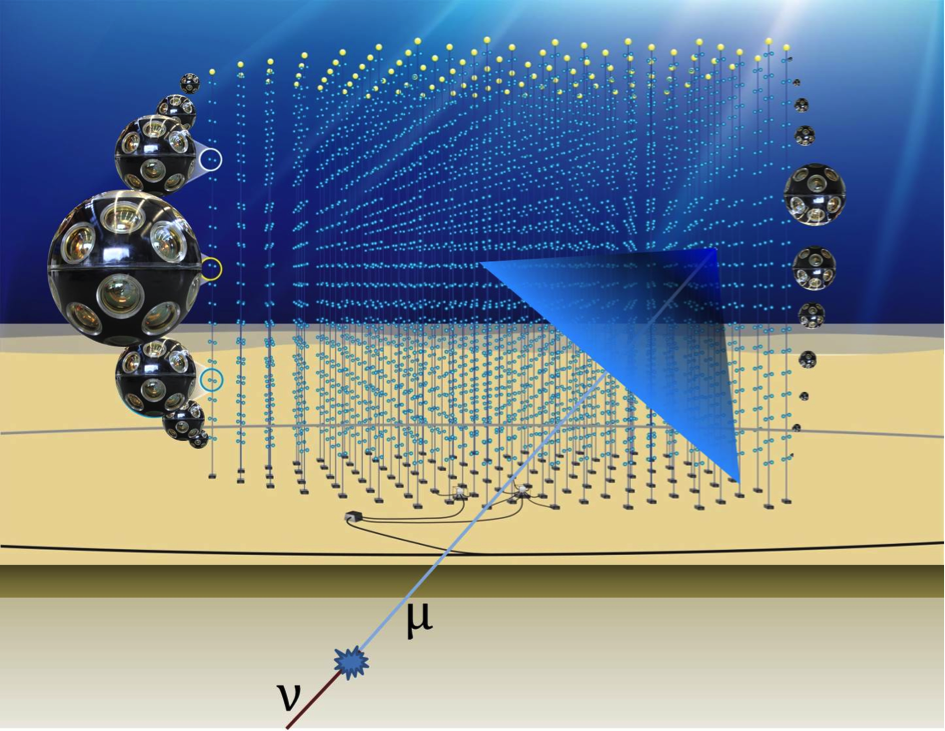I8: ARGOS Research of astroparticles, geological and oceanographic studies
> Read the articles connected to the project.
.
-
KM3NeT is the new generation neutrino telescope, on two deep-sea sites in the Mediterranean Sea : KM3NeT/ORCA near Toulon (France) and KM3NeT/ARCA near Capo Passero (Italy). It consists in 3D arrays of photomultipliers that detect the Cherenkov light emitted by the charged particles (muons, electrons,…) produced when a neutrino interacts near the detector.
The ARCA detector focus on the search for high-energy (~TeV-PeV) neutrinos from cosmic sources, while the ORCA detector addresses the fundamental properties of neutrinos by exploiting the abundant flux of atmospheric neutrinos of lower (~GeV) energy. The facilities on both sites also house instrumentation for Earth and Sea sciences for long-term and on-line monitoring of the deep sea environment and the sea bottom at depth of several kilometers.
The KM3NeT detector provides new scientific and technological opportunities for interdisciplinary collaborations with Earth and Sea Sciences. The ARGOS project (Astroparticle Research, Geology and Oceanography Studies) aims at federating the available expertise at APC and IPGP, establishing a framework for long-term collaboration in the perspective of the development of the KM3NeT project.
Methodology :
Two main topics have been identified as starting points for joint activities within ARGOS :
Task 1 : Earth composition studies with atmospheric neutrinos
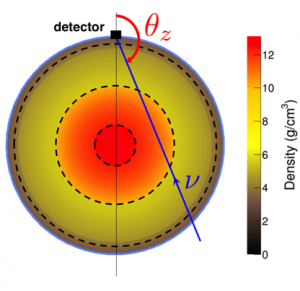 The flavor oscillation patterns of atmospheric neutrinos that traverse the Earth are affected by matter density and composition along their path. The main aim of this task is therefore to evaluate and develop the potential of atmospheric neutrino tomography as an alternative method to constrain the Earth composition, building on the complementary expertise of APC and IPGP teams.
The flavor oscillation patterns of atmospheric neutrinos that traverse the Earth are affected by matter density and composition along their path. The main aim of this task is therefore to evaluate and develop the potential of atmospheric neutrino tomography as an alternative method to constrain the Earth composition, building on the complementary expertise of APC and IPGP teams.The sensitivity of ORCA to changes in the composition of the inner Earth layers can be assessed through a full simulation chain including
- the generation of a realistic sample of atmospheric neutrinos in the energy range of interest
- the propagation of these neutrinos through the Earth, accounting for all oscillation effects
- the detection of the neutrinos in ORCA and the reconstruction of their energy and arrival direction on basis of the information (light pulses) deposited in the detector
- the determination of the sensitivity of ORCA for different inner Earth compositions, from the statistical study of simulated large samples of pseudo-experiments
The framework is used to evaluate the capabilities of an ORCA-like detector to constrain different Earth composition models, using inputs from expert geophysicists from the IPGP.
Task 2 : Interdisciplinary exploitation of the KM3NeT Calibration Units
The KM3NeT team at APC is in charge of the design and construction of the Calibration Units (CUs) deployed among the detector lines and carry the calibration devices for the ORCA and ARCA detectors.
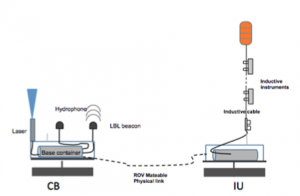 These units also include an inductive line hosting instruments for the monitoring of physical, chemical and biological parameters of the abyssal environment. The collaboration with Earth and Sea Science experts allows to turn the ORCA CUs into multi-purpose and testbed platforms for seismic and marine instrumentation that could be operated e.g. in collaboration with the EMSO network.
These units also include an inductive line hosting instruments for the monitoring of physical, chemical and biological parameters of the abyssal environment. The collaboration with Earth and Sea Science experts allows to turn the ORCA CUs into multi-purpose and testbed platforms for seismic and marine instrumentation that could be operated e.g. in collaboration with the EMSO network.The main challenges of this task is:
- the mechanical and electronical integration of the calibration and measurement devices onto the CU frame or the inductive line
- the definition and uniformisation of the data transfer protocol among all the instruments that will be plugged on the inductive line, in accordance with the global infrastructure of the KM3NeT detector
- the assessment of the scientific potential of instruments as related to geo- and marine science, and the exploration of possible technological developments, for which the expertise of IPGP members is essential.
-
WP leader Véronique Van Elewyck APC Maitre de conférences UP7 WP co-leader Miles Lindsey Clark APC Ingénieur de recherches CNRS WP co-leader Mathilde Cannat IPGP Directrice de recherches CNRS WP member James Badro IPGP Directeur de recherches CNRS WP member Wayne Crawford IPGP Chargé de recherches CNRS WP member Edouard Kaminski IPGP Professeur IPGP WP member Eleonore Stutzmann IPGP Professeur IPGP WP member Pascal Bernard IPGP Physicien IPGP WP member Antoine Kouchner APC Professeur UP7 WP member Alexandre Creusot APC Maître de conférences UP7 WP member Claude Boutonnet APC Ingénieur d’études CNRS WP member Daniel Cobas APC/IPGP Ingénieur d’études UP7 (LabEx) WP member Stéphane Colonges APC Ingénieur de recherche CNRS WP member Rémy Le Breton APC ATER UP7/CNRS WP member Simon Bourret APC Ph.D. student (ED STEP’UP) Ecole Polytechnique -
Since the publication of the project Letter of Intent in 2016, KM3NeT has achieved important milestones, including the deployment of the first detection units (DUs) on both French and Italian sites. A prototype of ORCA with 7 detection lines is expected to be deployed in the upcoming year, allowing for a proof of concept of the detector and first studies with real data; additional funding has already been secured from France, Italy and the Netherlands to proceed further towards the construction of the full detector (115 lines).
In this context, the studies undertaken within the ARGOS project are extremely timely:
‐ the physics case of ORCA, while centered on the measurement of the NMH, is reinforced by the opportunity of other measurements, e.g. on sterile neutrinos and on measurements of the inner Earth composition (Task 1)
‐ the first KM3NeT Calibration Unit (under responsibility of the APC group) should be ready to be deployed shortly after the installation of the ORCA prototype detector, i.e. probably by the end of 2018 (Task 2)
Conference presentations
- “Earth tomography with KM3NeT/ORCA”
S.Bourret, J. Coelho, A. Kouchner and V. Van Elewyck
Poster presented at the Neutrino 2016 conference in London (UK), 4-9 July 2016
Link to the poster: https://www.km3net.org/wp-content/uploads/2016/07/KM3NeT_poster_tomography_ISAPP_Simon_Bournet.pdf
- “Probing new physics with atmospheric neutrinos at KM3NeT-ORCA”
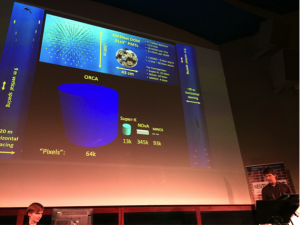 J.Coelho, A. Kouchner, V. Van Elewyck
J.Coelho, A. Kouchner, V. Van Elewyck
Poster presented at the Neutrino 2016 conference in London (UK), 4-9 July 2016Link to the poster: https://www.km3net.org/wp-content/uploads/2016/07/JCoelho_201607_Poster_Neutrino_KM3NeT.pdf
This poster presents the prospects of searching with the ORCA detector for new physics phenomena, such as sterile neutrinos and non-standard interactions, using atmospheric neutrinos that traverse the Earth. This spin-off research exploits simulation and analysis methods similar to those developed for Earth tomography studies within the ARGOS project.
Joao was awarded one of the five Nature Prizes for the Best Poster (among 400 posters) and invited to present his results in a 5-min summary talk in a plenary session of the conference.
- “Earth tomography with KM3NeT/ORCA”
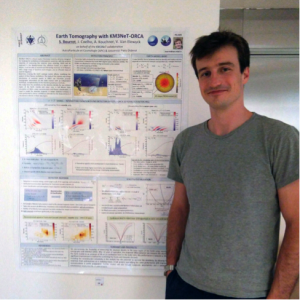 S.Bourret, J. Coelho, A. Kouchner and V. Van Elewyck
S.Bourret, J. Coelho, A. Kouchner and V. Van ElewyckPoster presented at the ISAPP Summer Institute on “Using particle physics to understand and image the Earth”, 11-21 July 2016, Gran Sasso Science Institute (L’Aquila, IT).
Link to the poster: https://www.km3net.org/wp-content/uploads/2016/07/KM3NeT_poster_tomography_ISAPP_Simon_Bournet.pdf
In this contribution, S. Bourret showed preliminary results on the potential of the ORCA detector for imaging the interior of the Earth using neutrinos penetrating the globe, based on a simulation chain developed within the framework of the ARGOS project.
Simon received a Prize for the Best Poster and he was invited to present his results in a plenary talk during the School.
-
Adrian‐Martinez et al. [KM3NeT Collaboration], Intrinsic limits on resolutions in muon and electron‐neutrino charged current events in the KM3NeT/ORCA detector JHEP05 (2017) 008
Bourret, J. Coelho and V. Van Elewyck for the KM3NeT Collaboration, Neutrino oscillation tomography of the Earth with KM3NeT/ORCA J. Phys. Conf. Ser. 888 (2017) 1, 012114
Coelho for the KM3NeT Collaboration, Probing new physics with atmospheric neutrinos at KM3NeT/ORCA J. Phys. Conf. Ser. 888 (2017) 1, 012115
Bourret, J. Coelho and V. Van Elewyck [for the KM3NeT Collaboration], Neutrino oscillation tomography of the Earth with KM3NeT/ORCA PoS(ICRC2017) 1020

